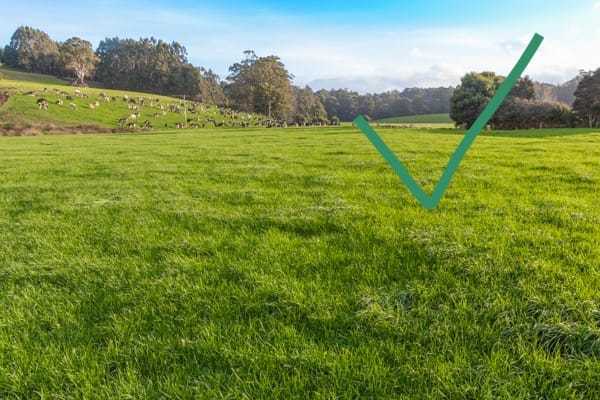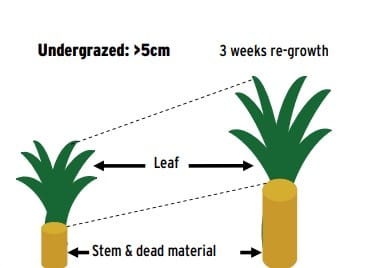Are you constantly looking at ways to get the most of your pasture?
Did you know that accurate pasture allocation can work wonders for your farm?
It can help you optimize animal feed intakes, improve production and lower your feed costs.
In this article, let’s explore how calculating pre-grazing and post-grazing covers can help you gain with efficient pasture allocation.
Let’s begin by understanding why is pasture allocation so important?
It’s important because a grass-only diet can help you optimize production and lower your feed costs. But, to do that, you need to make sure your animals get enough quantities of quality pasture.
When the pre-grazing yield exceeds the right level, it causes a decline in grass quality as well as poor weight gain.
And we definitely don’t want our cows to be size zero, do we?
Completing the first rotation on time is critical for mid-season grass supply and quantity as this guarantees that grass will be easily managed in the second and successive grazing rotations.
If you finish the first rotation too early, the animals will end up grazing on too short a rotation and the grass will run out. On the other hand, if you finish the first rotation too late, it results in excess grass making it tough to achieve post-grazing residuals.
Below is a handy grazing guide that you can easily refer to so that the important numbers are always at your fingertips.

For maximum animal performance, the ideal pre-grazing yield you should follow is between 2,700 and 3,200 kg DM/ ha This is based on a high average pasture intake of about 18 kg DM/ cow/ day.
When you’re pre-grazing yields are between 2700 and 3200 kg DM/ ha, it will be easier for you to achieve two outcomes.
Firstly, this allows your cows to graze enough pasture to maintain live weight and improve production.
And secondly, it also prevents over-grazing or under-grazing and allows you to achieve post-grazing residuals around 1500 kg DM/ ha. This residual level is crucial for optimum pasture regrowth.
Sometimes your animals may have lower dry matter intakes (DMI) than this, as low as around 14 kg DM/ cow/ day. This may happen either because they are at the end of their lactation period or because of weather conditions.
In such cases, you might consider a pre-grazing yield that is less than 2,500 kg DM/ ha. However, for best results, post-grazing residuals must be around the 1,500 kg DM/ ha mark.

Under-grazing will lead to a higher proportion of stem. This results in lower grass quality and animal performance.

Under-grazed pastures will have a higher proportion of plant stem and dead material. This may not always offer optimum nutrition for your animals.
And finally, over time, under-grazed pastures will also result in poorer quality swards and more weeds.

So remember not to graze paddocks that have more than 3,500 kg DM/ ha. Instead, consider saving this surplus grass as hay or silage.
On the other hand, when you graze your animals on a paddock that has between 2,700 and 3,200 kg DM/ ha they will eat more leaf biomass and result in quicker re-growth levels. Both of these are excellent outcomes for your farm.
Managing Your Yields:
To get optimal dry matter yields from your pasture, you need to have a sound grazing management plan in place.
- Understand your target covers and set the right rotation lengths based on the assessment of leaf stage for your farm.
- Keep a stringent watch on cow intake and residuals. Use an RPM (or our automatic pasture growth measurement tool) to accurately assess your pasture.
- Manage your pastures by leaf stage, especially for ryegrass-based pastures.
- Achieving residuals could be challenging due to weather conditions. If there is high rainfall, your target residuals might not be achievable but you could always take steps to correct the residuals whenever possible, for instance, a lower pre-grazing yield in the next rotation.
Calculating Pre-Grazing Yields & Post-Grazing Residuals:
Calculate pre-grazing cover by using this simple formula:
Pre-grazing Cover = (Stocking rate x pasture intake x rotation length) + optimum residual
For example, if you have a stocking rate of 4 cows/ha, multiply this figure by cow intake which we’ll estimate as 18 kg of DM per day which makes 4 x 18 = 72
Also, let’s say that your rotation length is 21 days. So, 21 days x 72 kg = 1512 kg DM/ ha
And, to ensure optimum regrowth let’s take the post-grazing residual to be about 1,500 kg DM/ ha. When you add all this together you get about 3,012 kg DM/ ha.
So for this example, an ideal pre-grazing yield ballpark needs to be around 3,000 kg DM/ ha.
Achieving Post-Grazing Residuals:
To achieve good post-grazing residuals, ensure accurate pasture allocation, calculate pre-grazing cover, evaluate cow intake, rotation length and always be sure to use corrective measures just in case your targets aren’t met.
Your grazing residuals will be the main indicator of your pasture utilization rate.
Poor utilization rates result in high post-grazing residuals, also known as pasture wastage.
Furthermore, high post-grazing residuals may also reduce the growth of the pasture and affect how well your animals digest what they’ve grazed. This can have an adverse effect on animal performance.
An important aspect to remember in late spring is that stem elongation will occur, thereby increasing the amount of stem in the pasture being eaten. If this isn’t managed well, it could probably lead to an increase in post-grazing residual height.
If this carries over to the summer, cows will be left with no other option but to eat the lower quality stem.
If you focus more on achieving target residuals in spring, it will help minimize the increase in grazing residual.
Meanwhile, the winter season offers excellent opportunities to reset residual levels and focus on improving leaf growth at the base of the pasture.
Calculating Pasture Growth Rates:
Now let’s turn our attention to calculating your pasture growth rates:
- First, you start off by measuring grazing residuals for each paddock just after a round of grazing has been completed. Say 1,500 kg DM/ ha
- Then you measure again just before grazing. Say 2,900 kg DM/ha. This means that your pastures have grown 1,400 kg DM/ ha since your last grazing
- Divide this by the number of days between measurements, for instance, 22 days. Dividing 1400 by 22 gives you an average growth rate of 63 kg DM/ ha/ day
You could use boards or charts to record grazing dates for individual paddocks. And use this information to record and compare pre-grazing and post-grazing covers.
But as you can imagine, this can quickly get out of hand and you may find yourself in a situation that demands better data and record management.
Consider using our forever free plan to store all your pasture growth measurements and farm records digitally.
Over time, you’ll build up a repository of information that can help you take effective animal feed and pasture management decisions.
Being on top of your key numbers – whether it’s setting your targets or grazing based on correct post-grazing residual will do wonders in upping your farm’s overall performance.
Also, if you’re interested, please do check out what we’re building at Pasture.io.
We’ve helped our farmers earn more than $60,000 dollars a year in additional profits from their pasture.
We can help you achieve similar results as well. Do let me know if you would like to receive more information on this.
I hope you found this piece of information useful.
Until we meet again, happy farming!
- The Dedicated Team of Pasture.io, 2020-08-27